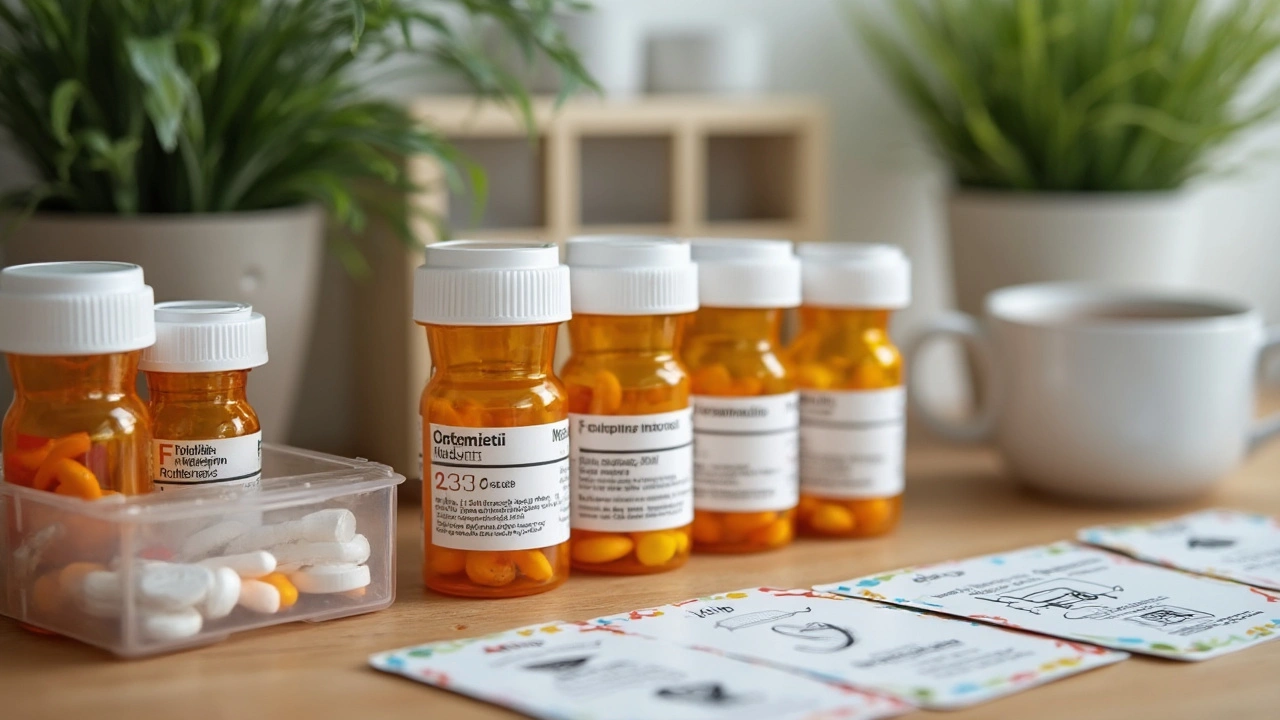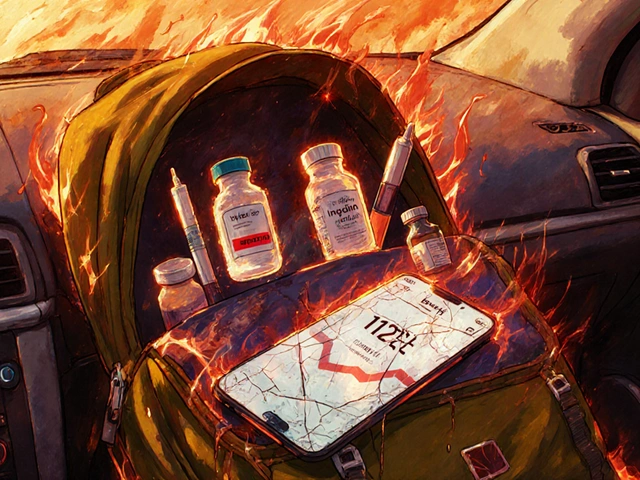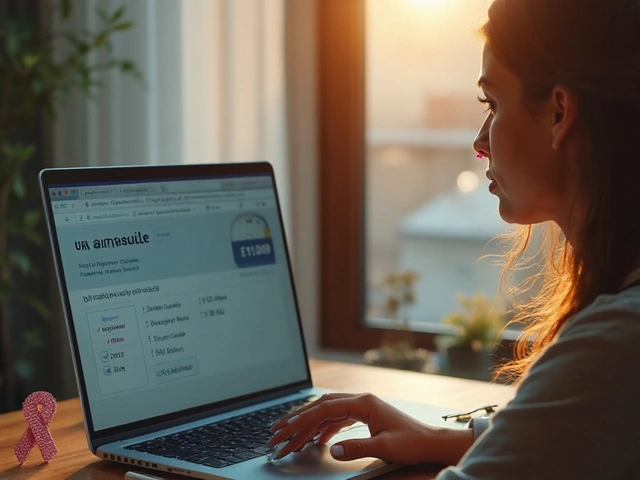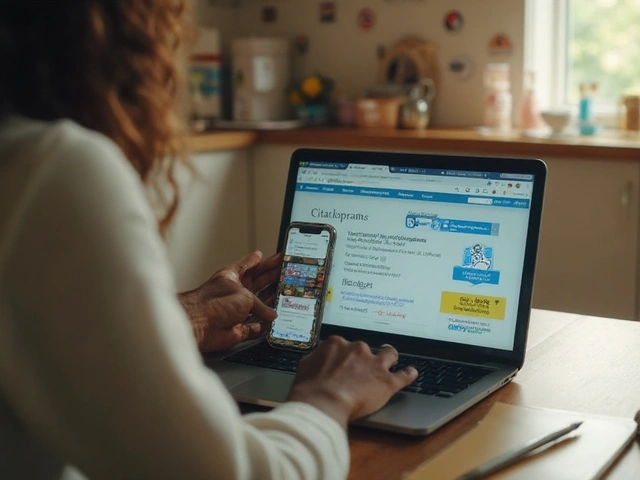Chlorambucil might sound intimidating, but it helps tackle some of the toughest cancers out there—think chronic lymphocytic leukemia and certain lymphomas. If your doctor has brought up this med, you’re probably wondering what to expect and how it works in real life, not just what’s on the label. That’s exactly what you’ll get here, minus the fluffy language and complicated jargon.
Instead of guessing or stressing about dosing, you’ll get a clear breakdown of what actually happens each step of the way. Wondering whether you can give chlorambucil with food? What about safe handling? We’ll get into the nitty gritty, so you’ll know when you need gloves, what to do if a pill drops, and how to keep things organized—especially useful if you’ve got a million other things to keep track of.
If you’re worried about side effects or how to spot a problem early, you’ll find tips that I’ve picked up not only from medical sources but also from people who’ve gone through this at home—sometimes even with their pets. (Barney, my parakeet, can’t take chlorambucil…but some cats and dogs actually do, and the basics are pretty similar!)
This isn’t just a medicine you take and forget about; it takes planning and clear instructions. Let’s get started by laying out what chlorambucil is and when doctors suggest it—so you’re not left in the dark before you even open the pill bottle.
- What Is Chlorambucil and When Is It Used?
- Getting Ready: Important Precautions Before Starting
- Figuring Out the Right Dosage
- Steps for Giving Chlorambucil Safely
- Dealing With Side Effects and What to Watch For
- Tips for Making the Whole Process Easier
What Is Chlorambucil and When Is It Used?
Chlorambucil is a chemotherapy drug doctors use mainly for certain blood cancers. It's in a group called alkylating agents, which means it messes with how cancer cells multiply and spread. You’ll usually hear about it when someone has chronic lymphocytic leukemia (CLL) or some kinds of lymphoma—like Hodgkin’s and non-Hodgkin’s. Sometimes, it’s also used for rare problems where the immune system is causing trouble, or even for a few cancers in pets.
Most of the time, chlorambucil comes as a pill that you swallow, usually once a day or a few days out of every month. It's not the kind of chemo where you have to sit in a hospital chair with an IV for hours. That’s a huge relief for people who want to handle part of their treatment at home.
The main cancers chlorambucil treats include:
- Chronic lymphocytic leukemia (CLL): This is the most common reason a doctor prescribes it. It slows down how fast the white blood cells are multiplying.
- Lymphomas: Especially certain slow-growing types, like follicular lymphoma or some forms of Hodgkin’s disease. If other treatments don’t work or aren’t a good fit, docs might go with chlorambucil.
- Waldenström’s macroglobulinemia: Pretty rare, but this is another situation where chlorambucil can help reduce the number of abnormal cells.
This drug is mostly for adults, but veterinarians sometimes prescribe it for cats and dogs with similar blood cancers (yep, even pets can get something close to human chemo in special cases).
Check out this quick chart showing how often chlorambucil gets used for different conditions:
| Condition | Chlorambucil Usage |
|---|---|
| Chronic lymphocytic leukemia (CLL) | Very often, first-line in older adults |
| Lymphoma (various types) | Sometimes, mostly slow-growing lymphomas |
| Waldenström’s macroglobulinemia | Occasionally, if other drugs don’t work |
| Pet cancers | Rare, but increasing in veterinary medicine |
You won't usually get chlorambucil unless your cancer team thinks it's the right move for your type and stage of cancer. It’s not a cure-all—docs pick it when they know the specific cancer responds to this drug, or when someone has trouble with more aggressive chemo.
Getting Ready: Important Precautions Before Starting
Before you do anything with chlorambucil, you’ve got some checks to make. Not everyone can take this drug safely, and missing these steps can cause bigger problems down the road. A little planning now beats a big headache later.
- Blood Tests Are a Must: The doctor will probably order blood work to check your white cells, red cells, and platelets. Chlorambucil can whack your bone marrow, so you need a baseline to spot any trouble fast.
- Be Honest About Other Meds: The chemo can clash with everyday stuff—like gout meds, allopurinol, even regular painkillers. Always give the doc the whole list, even vitamins and herbal things.
- Tell Them If You’re Sick (Even Just a Cold): Immune systems take a hit with chlorambucil. If you have any infection starting out, your risk ramps up. Let your doctor know about fevers, coughs, or open wounds.
- Pregnancy Alert: Chlorambucil is a big no for pregnant women or anyone planning a kid soon. It can cause birth defects, and it’s the kind of thing you want to double-check about, even if the chances seem low.
- Safe Storage and Handling: These pills aren’t just like aspirin. You need to keep them out of reach of little kids and animals (Barney, my parakeet, will chew through anything shiny). Store them in the original bottle, away from sunlight and moisture.
- Gloves for Handling: When handling chlorambucil tablets, you’re advised to use disposable gloves—just to avoid getting it on your skin. Wash your hands well after, even if you used gloves. If you drop a pill, pick it up with tissue and wipe down the area.
If you want specifics, here’s a snapshot of things folks usually check before the first dose:
| Test/Check | Why It Matters |
|---|---|
| Blood count (CBC) | Baseline for safety—most dosing calls for weekly checks at the start. |
| Liver/kidney function | Chemo is hard on these organs, especially if there are existing problems. |
| Infection screen | Catching even small bugs early means less risk during treatment. |
A few other things to keep in mind: No recent live vaccines, don’t share the medication with anyone else, and always talk to the doctor if something feels "off" before starting the first round. The clearer you are before you start, the less stress down the line.
Figuring Out the Right Dosage
This is where things get technical, but also the most important—getting the chlorambucil dosage right can make a huge difference in how well the drug works and how safe it is. There’s no “one size fits all” because doctors set the starting dose based on your body weight, height, type of cancer, and how your body’s working overall (especially your liver and kidney functions).
The usual starting point for adults with chronic lymphocytic leukemia is about 0.1 to 0.2 mg per kilogram of body weight per day. That translates to roughly 6 to 12 mg a day for a person of average weight, but your doctor will do the math for you. For kids or for certain types of lymphoma, things can be different, so don’t try to guess based on someone else’s prescription.
| Use | Typical Starting Dose | Notes |
|---|---|---|
| Chronic Lymphocytic Leukemia | 0.1-0.2 mg/kg/day | Once daily, usually for 3-6 weeks |
| Hodgkin Lymphoma | As part of combination therapy | Dose varies, not always daily |
| Non-Hodgkin Lymphoma | 0.1-0.2 mg/kg/day | Doctor may adjust schedule |
“Always remember, there’s rarely such a thing as a perfect dose from day one. You want the lowest dose that can still get the job done,” says oncologist Dr. Pauline Ng in a recent interview.
"Dosing isn’t set in stone. We check labs every week at first and tweak as needed. Safety first, always."
Doctors almost always start low and ramp up, especially if you’ve never had this chemo before. They check your blood counts before, during, and after you start chlorambucil. If you get low white blood cells or other major dips, they’ll back off or pause the meds for a bit.
- Never double up if you miss a dose—call your doctor.
- If you’re on other chemo drugs, the dose may be adjusted down.
- Liver or kidney problems? Your doc will likely use an even lower starting dose.
It’s easy to get overwhelmed by numbers and tables, but the main thing is: don’t adjust your own dose. Let the medical team decide. And if things change—like new side effects or changes in your labs—tell them right away. The goal is to keep you safe while staying on track with your chlorambucil treatment.

Steps for Giving Chlorambucil Safely
Giving chlorambucil the right way isn’t hard, but missing a step can lead to problems—either for you or the person (or pet) taking it. Here’s how you actually handle and dose it like a pro.
- Wash your hands: Before you do anything with chlorambucil, wash up. This stuff is chemo, so touching it without clean hands is never a good idea.
- Wear gloves if handling pills directly: Use disposable gloves, especially if you’re splitting tablets (sometimes needed for small dose adjustments). Chemo drugs can absorb through the skin. Never crush or break the tablets unless your doctor tells you it’s safe.
- Double-check the dose: Chlorambucil commonly comes in 2 mg tablets. Your prescription will list the exact number of tablets to take. Always check the pill bottle label—no eyeballing it or guessing.
- Give with or without food: Most doctors say it’s okay to take chlorambucil with or without food. If it causes stomach upset, a light snack can make it easier to tolerate.
- Take at the same time: Set a reminder or use a pill organizer. Taking chlorambucil at the same time every day helps keep it working right and makes it easier to remember.
- Drink a full glass of water: Swallow the tablets whole with water. Don’t chew or dissolve them.
- Clean up properly: Toss your gloves after use and wash your hands again. If you spill a tablet, use gloves to pick it up and wipe the area with a damp paper towel. Put any contaminated stuff in a sealed plastic bag before throwing it away.
If you miss a dose, don’t double up. Just take the next dose when it’s due, and let your doctor know you missed one—especially if it happens more than once. Store chlorambucil in the refrigerator, but keep it away from food and drink, and make sure kids and pets (yes, even curious parakeets) can’t get to it.
Here’s a quick look at the typical handling steps for chlorambucil:
| Step | What To Do | Why It’s Important |
|---|---|---|
| Wash Hands | Before and after handling | Reduces risk of exposure or spreading drug residue |
| Wear Gloves | If touching tablets directly | Prevents skin absorption |
| Use a Pill Organizer | Plan your doses each week | Makes it easy to stay on schedule |
| Refrigerate Tablets | Keep in a safe, labeled spot | Preserves potency and keeps others safe |
If you’re nervous about starting, ask your pharmacist to show you safe handling steps before you take your first dose. Being extra careful with chemotherapy pills at home protects not just the patient, but everyone else in your household, too.
Dealing With Side Effects and What to Watch For
When starting chlorambucil, paying attention to side effects isn’t just a suggestion—it’s a must. This chemo drug is powerful and can affect more than just cancer cells. Most folks tolerate it pretty well at lower doses, but there are some things to keep an eye out for right from the start.
The most common side effect you’ll hear about is low blood cell counts. Chlorambucil can lower your white blood cells (which fight infection), red blood cells (which carry oxygen), and platelets (which help your blood clot). These drops don’t always happen right away, but your bloodwork will likely get checked every couple of weeks at first. Here’s a quick rundown of what makes this important:
| Side Effect | What to Watch For |
|---|---|
| Low White Blood Cells | Fever, sore throat, signs of infection |
| Low Red Blood Cells | Feeling weak, pale skin, shortness of breath |
| Low Platelets | Easy bruising, bleeding gums, nosebleeds |
Pay close attention if you feel more tired than usual or pick up any fevers while on chlorambucil. Infections can get out of hand fast, and you definitely don’t want to tough it out at home if your immune system is down.
Upset stomach, nausea, or throwing up can also crop up. Some people get diarrhea, while others lean the other way and get constipated. If you’re new to chemo, you might want some bland food around just in case your appetite bounces around. Take nausea meds as directed, and don’t wait to ask for help if you’re struggling to keep food or fluids down.
Mouth sores or "chemo mouth" show up for some. Sucking on ice chips, using gentle mouthwashes (no alcohol in them!), and keeping hydrated all help. If you get a painful sore, even a little one, mention it to your doc right away—open mouth sores are a welcome mat for germs.
Rare, but worth knowing: Chlorambucil can affect your liver or cause seizures (especially at higher doses or if there’s a kidney problem). Tell your doctor if you get yellow skin or eyes, have trouble waking up, or have any new or weird mental changes. Stick with the prescribed dosing and always check before adding other meds—some can interact poorly.
- Keep track of your temperature daily. Any fever above 100.4°F (38°C) means call your medical team, not just Google.
- If you see unusual bruises or bleeding you can't explain, speak up right away.
- Write down or snap a photo if you’re worried about a skin rash, so you can show your doctor instead of describing it later.
Just remember—most people take chlorambucil without big issues, but those regular check-ins and blood tests do matter. Catching a problem early is always easier (and a lot less scary) than dealing with it later.
Tips for Making the Whole Process Easier
There’s enough stress dealing with cancer meds—so let’s talk about making chlorambucil dosing and administration less of a headache. Trust me, the more you set up routines, reminders, and safe habits, the easier it gets.
- Pill routines matter. Taking chlorambucil at the same time every day helps you remember—and keeps blood levels steady. Use a pill organizer or set a daily alarm. Apps like Medisafe can send reminders to your phone.
- Keep hands safe. Always wear disposable gloves when handling the pills. If you’re cutting or splitting tablets (sometimes vets do this for pets), use a dedicated pill cutter and clean it after every use. Never use your bare hands or the kitchen cutting board.
- Food and drink check. Most doctors recommend taking chlorambucil on an empty stomach, but double-check with your healthcare provider. If you feel nauseous, eating a small snack first might be fine—just ask before you change anything.
- Storage matters. Store the medicine in a cool, dry place, away from kids, pets (Barney included), and food prep areas. The humidity in the bathroom isn’t great for these pills.
- Write stuff down. Record each dose and any side effects in a notebook or on your phone. Did you miss a dose? Was there a weird rash or a headache? That info is gold for your next doctor visit.
- Plan for extras. Accidents happen—maybe a pill drops on the floor, or you get thrown off by a last-minute plan. Keep the number for your local pharmacy and your doctor handy, along with a couple pairs of spare gloves just in case.
A lot of folks wonder what actually happens if things go off the rails—like two missed doses in a row. Here’s a quick list based on what’s usually recommended:
- If you forget a dose, take it as soon as you remember the same day. If it’s nearly time for the next dose, just skip the missed one. Never double up—that can be risky with chlorambucil.
- Keep emergency numbers and info on potential side effects (like mouth sores or sudden fatigue) where you can see them.
Here’s a practical table with what to keep on hand when you’re giving chlorambucil at home:
| Item | Why You Need It |
|---|---|
| Disposable gloves | Protects your skin from exposure |
| Pill organizer | Keeps doses on track |
| Pill cutter (if needed) | For accurate splitting |
| Notebook/phone | Track doses and side effects |
| Emergency contact sheet | Quick help if things go wrong |
No matter how organized you are, don’t be shy about asking questions or reaching out for help. Handling chlorambucil isn’t something most people do every day, and a small tweak to your routine can make a big difference in keeping everyone—yourself and your loved ones—safe and on track.









Look, I get it - chlorambucil’s just another fancy word for ‘chemo you don’t have to sit in a hospital for’ - but come on, who wrote this? A pharmacist who also runs a TikTok channel? I mean, we’re talking about a drug that can literally turn your bone marrow into a ghost town, and you’re telling me to use a pill organizer like it’s a damn bullet journal? I’ve seen more responsible advice on Reddit threads about how to cook ramen.
And don’t even get me started on the parakeet. Barney? Really? You’re comparing human cancer treatment to your pet bird’s hypothetical chemo? That’s not cute, that’s irresponsible. If I were my doctor, I’d prescribe you a vacation from writing medical guides.
Also, ‘safe handling’? Bro, if you’re touching these pills without a hazmat suit, you’re already losing. I’m not even mad - I’m just disappointed in humanity.
Okay, but let’s be real - this guide is *technically* accurate, but it’s dangerously casual. 🤔 You can’t just say ‘take with or without food’ and then casually mention pets without a disclaimer that vet dosing is *not* the same as human dosing. 🚫🐾
And you didn’t even mention the FDA’s 2023 advisory on alkylating agent exposure in household environments. 📌 If you’re not wearing nitrile gloves (not latex!), using a pill cutter designed for cytotoxic drugs, and storing it in a locked, child-proof container labeled ‘Cytotoxic - Do Not Handle Without PPE’ - you’re not just negligent, you’re endangering your community.
Also, ‘Barney the parakeet’? That’s not endearing - it’s unprofessional. 🐦💔 Please update this with proper citations and remove the anthropomorphizing. Thank you. 🙏
While the structural organization of this document is commendable - with clearly delineated subsections and a logical progression from pharmacological indication to practical administration - the tone, however, is profoundly suboptimal. The use of colloquialisms such as ‘messes with how cancer cells multiply’ and the casual reference to avian companions undermines the gravitas of the subject matter.
Furthermore, the absence of peer-reviewed references to clinical guidelines (NCCN, ESMO) is a glaring omission. One cannot, in good conscience, disseminate chemotherapy protocols without anchoring them in evidence-based literature. The inclusion of anecdotal pet data, while perhaps well-intentioned, constitutes an egregious breach of medical ethics and regulatory compliance.
I urge the author to revise this material in accordance with the standards of the American Society of Clinical Oncology, and to engage a medical editor prior to public dissemination. This is not a blog post. It is a therapeutic intervention protocol.
Respectfully,
Dr. D. Bradley, M.D., Ph.D.
Wait. Wait. Wait. You say ‘chlorambucil can cause seizures’ - but you don’t say ‘in rare cases, particularly with renal impairment or overdose’ - which is critical! And you mention ‘yellow skin’ - but you don’t say ‘jaundice’ - which is the actual medical term! And you say ‘call your doctor’ - but you don’t say ‘immediately’ - which is the only acceptable response!
Also - you say ‘Barney, my parakeet’ - and then you say ‘some cats and dogs actually do’ - so you’re implying Barney is a pet? But you don’t say whether Barney is alive? Or if Barney is a metaphor? Or if you’re just trolling?
This is not just sloppy - it’s dangerous. And you have no business writing about chemotherapy if you can’t even use punctuation correctly. Please. For the love of all that is holy - get an editor. Or a therapist. Or both.
LOL. You really think people are gonna follow this? 😂
‘Use gloves’ - yeah, right. Most people are just gonna pop these pills like aspirin. And ‘store in fridge’ - except the fridge is where the milk is, and kids grab stuff, and now your kid’s got chemo in their hands. 😭
This whole thing is a glorified Instagram post with a table. I’ve seen more accurate info on a Pinterest pin. And the parakeet? That’s not cute - that’s a lawsuit waiting to happen.
Just give me the pill. I’ll figure it out. 🤷♀️
They told you to write this so you’d think you were helping… but what if this whole thing is a distraction? 🤔
Chlorambucil isn’t just for cancer - it’s been used in covert ops since the 80s. The ‘pet’ thing? That’s not a coincidence. They want you to normalize it. Why? So when they start giving it to the water supply - you’ll say ‘oh yeah, I’ve been taking it for my CLL since 2019’
And the ‘pill organizer’? That’s a tracking device. You think they don’t know who’s taking it? Who’s missing doses? Who’s not complying?
They’re watching. They always are. 🕵️♂️
Barney? Barney’s a plant. I’ve seen him. He’s got a microchip. And he’s not a bird - he’s a data node.
Destroy this guide. Burn it. Then go live in the woods. 🌲💣
Actually, this is one of the clearest guides I’ve read on chlorambucil. I’ve been helping my cousin through CLL treatment, and the way you broke down dosing, storage, and side effects - especially the part about not doubling up doses - saved us from a scary mistake.
Also, the pet mention? It’s not unprofessional - it’s human. My uncle’s dog was on chlorambucil for lymphoma, and the vet used the same guidelines. It’s not a joke - it’s a real thing.
Just keep doing this. People need this kind of plain talk. No fluff. No jargon. Just facts with heart.
Thank you.